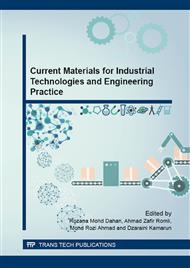p.88
p.96
p.103
p.109
p.116
p.123
p.127
p.131
p.138
Effect of Ozone Treatment on Properties of Screw Pressed and Non-Screw Pressed Empty Fruit Bunch Medium Density Particleboard
Abstract:
This study was done to investigate the effects of ozone treatment as a method to improve the properties of empty fruit bunch (EFB) medium density particleboard. Two types of EFB were used in this study i.e. screw pressed and non-screw pressed empty fruit bunch. These EFB were treated in an ozone chamber for 8 hours prior to particleboard manufacturing. The mechanical properties, Modulus of Elasticity (MOE), Modulus of Rupture (MOR) and Internal Bonding (IB) and physical properties, water Absorption (WA) and Thickness Swelling (TS) of EFB particleboard were determined. The results showed that the ozone treatment could increase the MOR and IB values of EFB particleboard, but had no significant effect on MOE values. For physical properties, the values showed no improvement for TS and WA. The panels manufactured using ozone treatment was found suitable for applications for furniture products.
Info:
Periodical:
Pages:
116-122
Citation:
Online since:
December 2015
Price:
Сopyright:
© 2016 Trans Tech Publications Ltd. All Rights Reserved
Share:
Citation:


